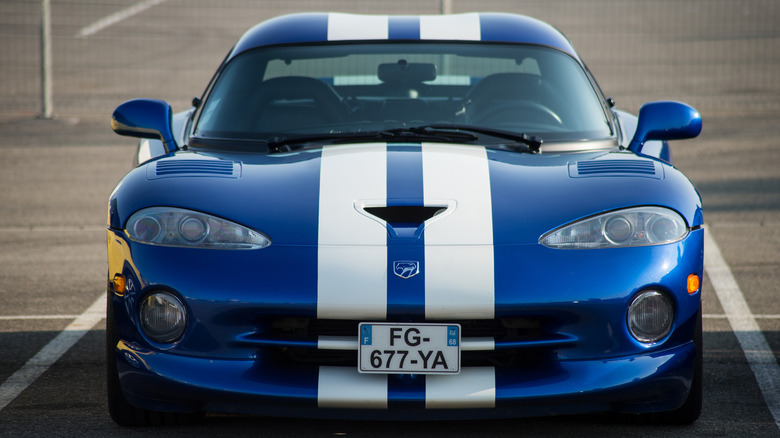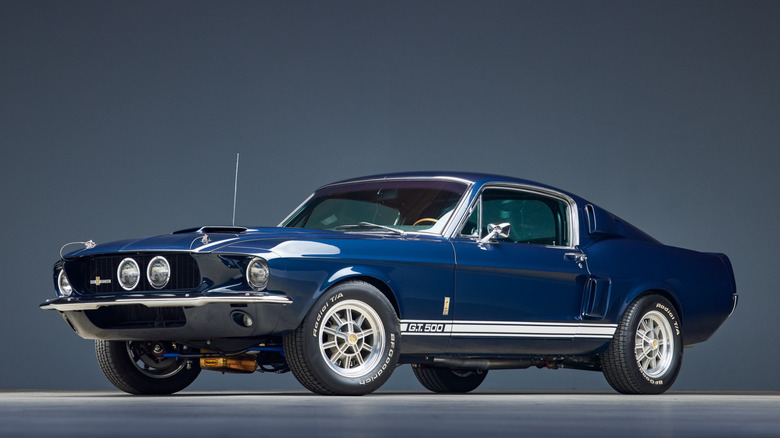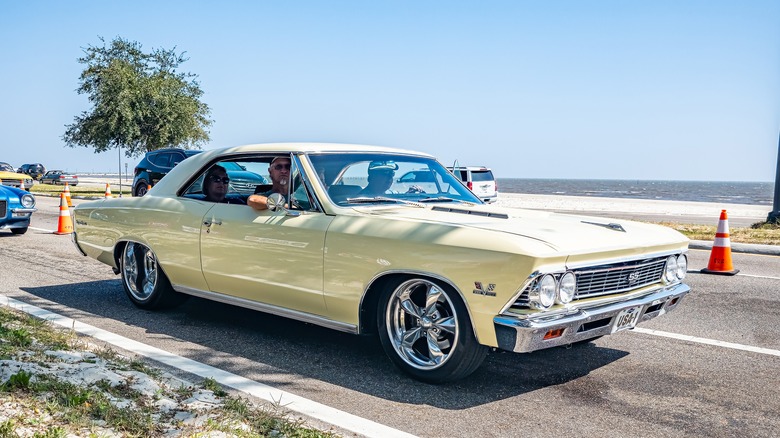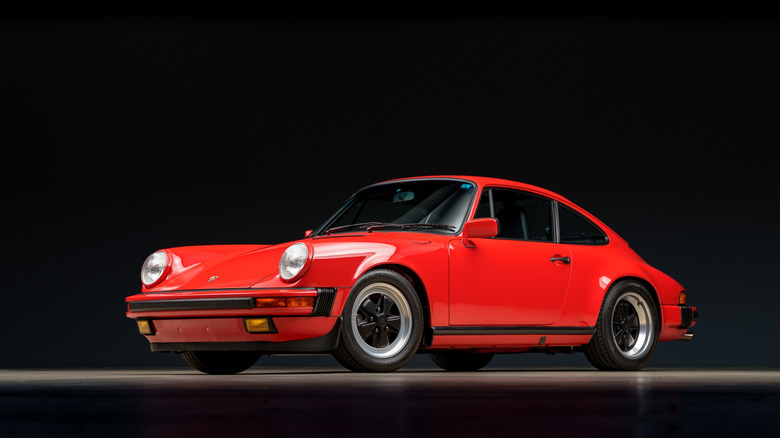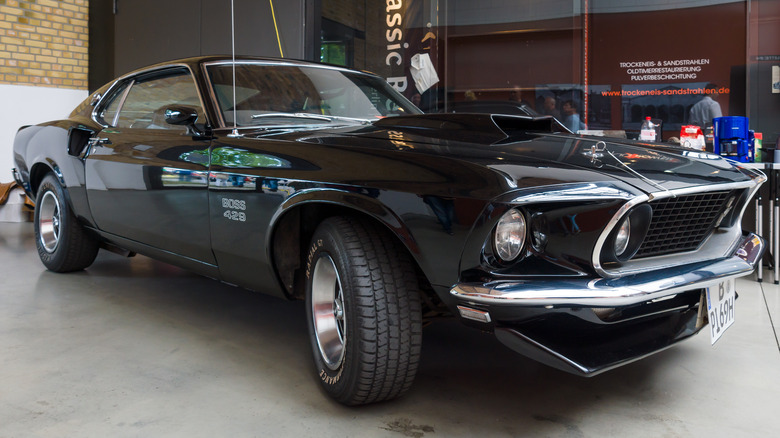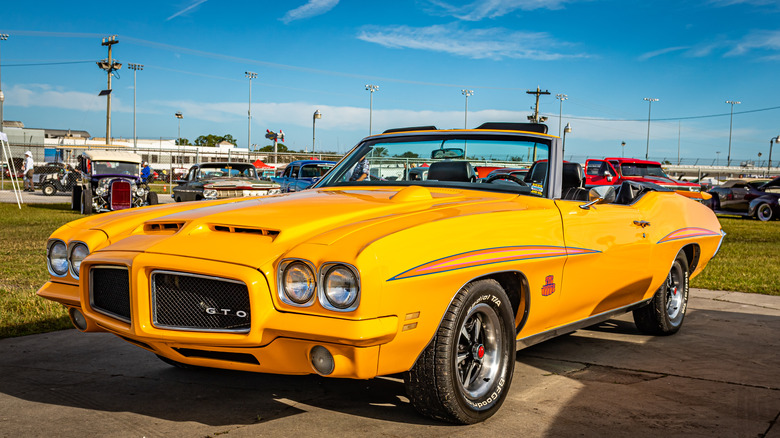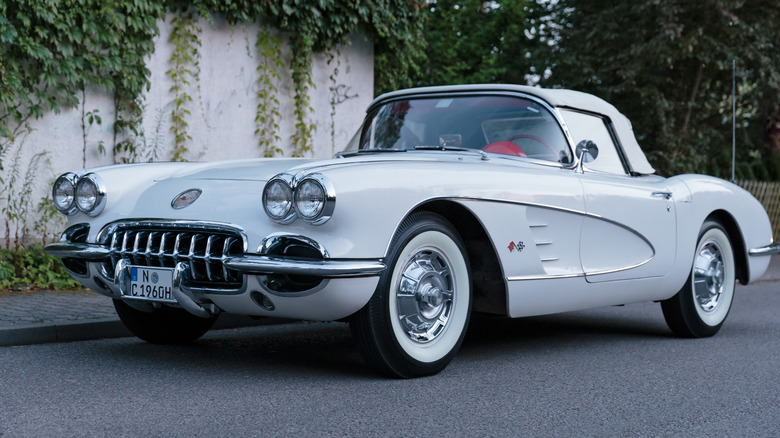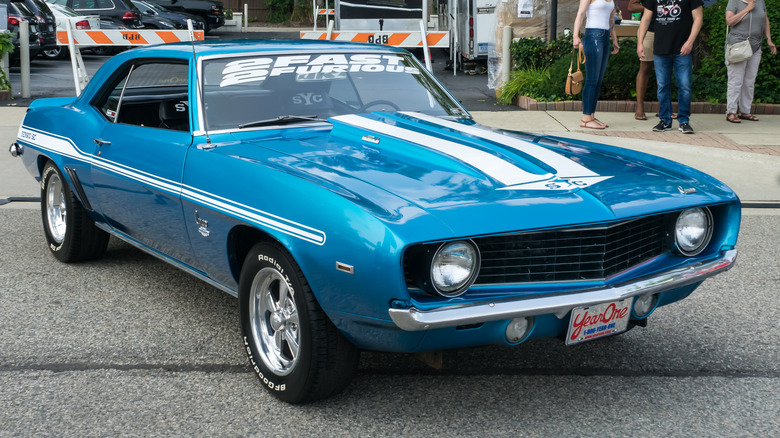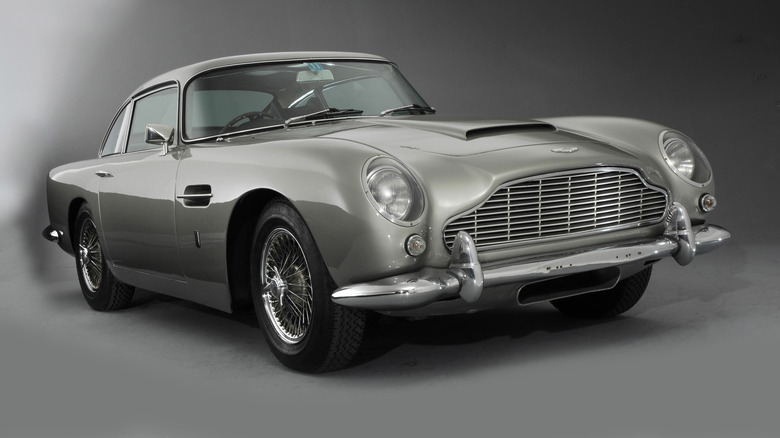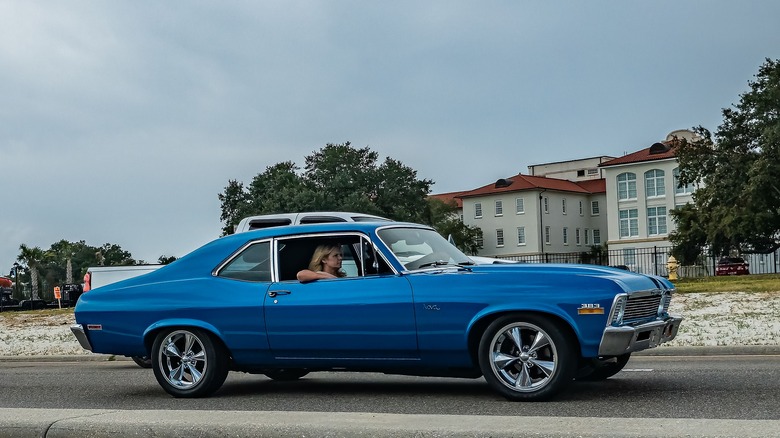10 Common Classic Cars Worth A Small Fortune Now
Human brains are wired to collect, to clutch a piece of the past. Scientists suggest this satisfies deep-rooted desires for control, identity, and connection to bygone eras. For many, this irresistible compulsion leads to preserving memories by acquiring coins, stamps, fine art, books, manuscripts, sports cards, and guitars. Others prefer classic cars, like the Jaguar E-Type, forming a visceral bond with the revving of a mighty engine and the vibration of the fingertips gripping the steering wheel. There's also the thrill of curating a personal museum and the pride of owning a real legend, like a car featured in movies driven by a beloved actor.
But this relationship is not just tied to nostalgia. A financial component plays a role here, too. For instance, a classic 1965 Lincoln Continental Special is worth a ton of money now, as well as an R107 Mercedes SL. If you owned any of them, or any other vehicle deemed a classic, such as a high-value 1959 Cadillac Series 62 Convertible, you could be sitting on a small fortune without realizing it. Each classic car carries its own story, and the ten cars on this list confirm that their rich legacy can likewise lead to significant profit.
1996 Dodge Viper SRII
Have you ever felt a low-frequency thump in your chest? Check your surroundings, as it might be a Dodge Viper SRII clearing its throat. After falling for this beast and finding one, be ready to disburse between $73,000 and $100,000, according to Classic.com. But if you're looking for a Viper in pristine condition and with very low mileage, it could reach over $185,000, also as per Classic.com. Keep in mind this is not a weekend toy, but an investment. A classic car gains value over time. But what makes this car a classic? Apart from the fact that it is not produced anymore, this supercar houses an 8.0-liter all-aluminum V10, a Borg-Warner T-56 six-speed drivetrain, and Michelin Pilot shoes (275/40 ZR17 front, 335/35 ZR17 rear), and in 1996 it led the field in front of millions in the Indianapolis 500.
Jeremy Clarkson from Top Gear described it as "an absolute animal" in The Guardian. Jay Leno, the famous TV host and vehicle collector, owns a 1996 blue with Wimbledon-stripe white Dodge Viper GTS, the coupe variant of the SRII generation. Speaking with Carscoops, he said that when the Viper launched with 450 horsepower, it put its rivals on notice. Just a note if you're not familiar with this car. It was designed as a raw, no-frills performance machine; no traction control, no stability aids, and no cup holders either. So please avoid putting any aftermarket additions to keep most of its value.
1967 Ford Mustang Shelby GT500
The 1967 Ford Mustang Shelby GT500 combines brute power, aggressive styling, and the lineage of racing legend Carroll Shelby, a famous Le Mans-winning driver and brilliant automotive designer. This Mustang is an additional example of a Ford classic car worth a small fortune — or perhaps not that small. According to J.D. Power, a 1967 Shelby has an average retail value of $193,200, with the lowest point around $127,800. In recent high-end sales reported by Classic.com, a GT500 Fastback was offered for $250,000 at Mecum in May 2025, with another listed at $299,999 by No Reserve Classics in January 2025. But a top-tier, rare, perfectly restored Mustang Shelby GT500 can exceed $300k, with the highest sale reaching $517,000 at auction in the last three years, as per Hagerty.
What makes this Ford so desirable? The fact that only 2,048 GT500s were produced, its unique and aggressive design that set it apart from the standard Mustang (a fibreglass hood with a functional scoop, a rear spoiler, and inboard grille-mounted high-beam headlights), and its symphony of power: a formidable 428 cubic inch 7.0-liter "Police Interceptor" V8 engine, topped with a pair of four-barrel Holley carburetors. Such immense energy, delivering 400 horsepower, is channeled through a choice of either a four-speed manual or a three-speed automatic transmission. Is it legal to drive one on the streets? Barely.
1966 Chevrolet Chevelle SS 396
As the first Chevrolet mid-sizer to go truly heavyweight, the 1966 Chevrolet Chevelle SS 396 is proud of being part of the exclusive muscle-car club. The long-stroke throb Super Sport boasts a cast iron big-block 396 cu in V8, strengthened by a 4-barrel Holley carburetor, and different transmission options such as the 3-speed manual Saginaw, the 4-speed manual Muncie, the Powerglide 2-speed automatic, or the 3-speed automatic TH400 (a staple in many GM muscle cars). Chevelle's factory rubber was 7.75-14 bias-ply red-stripe tires (Firestone or Uniroyal Tiger Paw) on 14 × 6-inch steel rims.
Its cabin atmosphere offered civility: strato-bucket seats, an optional center console and clock, round gauges set in an engine-turned dash panel, a "knee-knocker" tach, walnut-grain steering wheel, vinyl trim, air conditioning, and AM/FM on the tick-box list. But no cup holders. Why would you need them in a muscle car? When it comes to price, Autotrader says that a 1966 Chevelle SS 396 in good shape typically sells for around $65,884. However, a top-condition and highly original one pushes values well into and above the $180,000 range, as published by Hagerty, with some of them listing on Autotrader for up to $195,000. Again, getting a classic is more about investment rather than leisure. Though you can have a ride once in a while.
1984-1989 Porsche 911 Carrera 3.2 G-Body
This model is the eternal icon of sports car design and engineering. But before anything, how much would you have to invest in a Porsche 911 Carrera 3.2 G-Body? The average price, as per Classic.com, goes around $84,548. Nevertheless, rarity is everything in this market. To illustrate, a 1989 Porsche 911 Speedster (based on the 3.2 Carrera) has an average value of $218,000, and a 3.2 Carrera Club Sport can reach $234,329 as per Bring a Trailer — a small fortune. The heart of the Carrera is the upgraded version of the previous SC's 3.0-liter engine: a robust and reliable air-cooled 3.2-liter flat-six engine with the Bosch Motronic 2 for digital fuel injection and ignition. Such a power source delivers over 231 horsepower (207 for the US).
The cockpit exudes quality and purposeful design, with key features including the iconic five-gauge dashboard with the tachometer placed in the center, supportive seating (upholstery in durable leatherette and premium leather), floor-hinged pedals, optimized air conditioning, and the introduction of better sound systems. For the pavement, the Porsche 911 Carrera 3.2 was fitted with Fuchs alloy wheels and 195/65 VR15 front and 215/60 VR15 rear tires. Why is the Carrera 3.2 famous? Because it is regarded as the last iteration of the original 911 before the major revisions of the 964 model. Also, this Zuffenhausen machine offers a pure, unfiltered connection between the driver, the car, and the road with no electronic aids. And, of course, the enticing silhouette of its G-Body, a masterpiece that remains instantly recognizable.
1969 Ford Mustang Boss 429
Its average price is around $332,889, as published by Classic.com, but recent auctions position it in the range of $600,000, as per Hagerty. But why so covetable? With just 859 produced, the 1969 Ford Mustang Boss was built as a homologation special, allowing Ford to unleash the powerful 429 "Boss" into NASCAR, where it secured 26 victories in 1969. Its 500-horsepower engine is a 429 cubic inch 7.0-liter V8 with forged aluminium pistons, semi-hemi aluminium cylinder heads with modified hemispherical combustion chambers, and a single Holley 4-barrel carburetor mounted on an aluminium intake manifold. In terms of transmission, the "Boss" came with the Ford Toploader 4-speed manual.
Given the big size of everything, the battery was relocated to the boot to help with weight distribution. To do the burnout, Ford installed 15×7-inch Magnum 500 steel wheels with Goodyear F60-15 Polyglas GT bias-ply rubber. Cockpit-wise, every '69 Boss received the Deluxe Decor pack: black Comfort-Weave high-back buckets, a full-length console, wood-grain appliqué, AM radio, and an 8,000-rpm tach. The only thing this monster lacked was climate control. Why? An A/C compressor couldn't fit next to such a super-sized engine.
As a curious note, people think that John Wick was driving a 1969 Ford Mustang Boss 429 in the first movie. The scene: Iosef Tarasov sees the car at the gas station and asks John, "Nice ride. Mustang. Boss. 429. She a '70?" and John Wick corrects him, saying, "69." But in reality, the cars used in the film were primarily 1969 Ford Mustang Mach 1s, dressed up to resemble the Boss 429.
1971 Pontiac GTO Judge Convertible
Arguably rare? Absolutely. Cherished by collectors? Without a doubt. The 1971 Pontiac GTO Judge Convertible is a legend that came shortly ahead of government emission regulations and rising insurance payments. The Judge option included a total of 357 units produced across all body styles, but Pontiac just made 17 convertibles. So, if you want one of them in pristine condition, be ready to unleash your coffers and invest between $200,000 and $400,000. However, if you pray and are lucky enough to find an average one, it might be in the $72,000 – $80,000 range, according to ConceptCarz. Bear in mind restoration costs — these can quickly skyrocket.
Before you make an important financial decision, look at what's under the hood: a 455 HO (High Output) V8 with a Rochester Quadrajet four-barrel carburetor delivering 335 horsepower at 4,800 RPM and a three-speed manual or a Turbo Hydra-Matic automatic transmission. Dealing with an immense 480 lb-ft of torque at a low 3,600 RPM requires wide G60-15 bias-ply tires mounted on 15×7-inch Pontiac Rally II wheels. To cool the beast in rage moments, the Judge features two side-by-side hood scoops, directing cooler, denser air directly to the carburetor to improve performance. Installed in the cockpit, high-back bucket seats stand out, along with a thick-rimmed, three-spoke steering wheel, a full set of gauges including a speedometer and tachometer, engine-turned aluminum dash trim, and "The Judge" emblem as the cherry on top adorning the glove compartment door.
1960 Chevrolet Corvette
Here's Chevrolet again with one of the most highly sought ones: the 1960 Corvette. With its small block, it proved America could dance with Europe on their own circuit. The set date was 25 June 1960 at Circuit de la Sarthe. On that day – sunny initially, but later drenched in heavy rain – three Corvettes entered the 24 Hours of Le Mans for the first time under Briggs Cunningham's leadership. Despite not winning the race, the fact that the #3, driven by John Fitch and Bob Grossman, finished confirmed the Corvette's endurance and potential. Before peeking under the bonnet, know how much you should pay for one of these marvels. A 1960 Corvette in excellent condition goes between $70,950 and $99,000, in accordance with Hagerty. But ConceptCarz values an original in top-notch shape between $120,000 and $550,000. Another option is a 1963 Corvette, also worth a small fortune, with prices ranging $77,200 – $191,000.
Now, the heart of the 1960 Corvette beats within a 283 cubic inch 4.6-liter V8 with a Carter WCFB 4-barrel carburetor, delivering 230 hp or 315 hp with Ramjet Fuel Injection. The transmission came from Borg-Warner, a T-10 four-speed cracking 0-60 mph in the low seven-second bracket. As for shoes, this Corvette runs on 6.70-15 Firestone Deluxe Champion bias-plies mounted on steel wheels capped by turbine-style hubcaps. Once inside, you'll notice the low-slung bucket seats in vinyl, the machine-turned alloy dash fascia packed with a 160 mph speedometer and 6,000 rpm tach, the chrome-bezel Wonderbar AM radio, a centered analogue clock, an optional heater, and a hardtop. Isn't it beautiful?
1967 Chevrolet Camaro Yenko
An apex predator; a high-performance stallion built not for the street but to win races. That is the 1967 Chevrolet Camaro Yenko, a car you could not simply buy off a showroom floor. Rather, it was a special-order vehicle created by famed race driver and dealership owner Don Yenko, leveraging his expertise to craft one of the most potent muscle cars of its era. It is estimated that only around 54 Yenko Camaros were produced. Hence, their scarcity makes them incredibly valuable. As per J.D. Power, to get a genuine 1967 Camaro Yenko, consider spending between $463,900 and $632,500. This is echoed by an auction listed by Hagerty. Here's this Camaro's story.
In the 1960s, from his Canonsburg, Pennsylvania dealership, Don Yenko ordered top-of-the-line Camaro SS models, which brought the L78 396 cu in V8. He then directed his mechanics to remove those engines and install Chevrolet's formidable L72 427 cubic inch 7.0-liter V8 with four-barrel Holley carburetors instead. That's when the 425-450 horsepower beast came to life. In the interior, Yenko's version remained almost the same as the standard Camaro SS, but he added Stewart-Warner gauges and "Yenko Super Camaro" emblems and badging to proudly announce the car's pedigree. If you want to see a replica of this car in action, watch the 2003 "2 Fast 2 Furious" film when Brian O'Conner won a Yenko in a race against Korpi (John Cenatiempo). In the same movie, another scene shows O'Conner crashing it onto the top of a boat.
1964 Aston Martin DB5
Do you have the vibe of a secret agent? If so, consider investing in a DB5. As per Hagerty, a 1964 Aston Martin DB5 in good condition is valued between $348,589 and $510,579. However, Classic.com and ConceptCarz highlight pristine, meticulously detailed examples fetching $667,000 or more at auction. Why is this British mix of grace and danger so valuable? Firstly, the Star Wars special effects supervisor, John Stears, chose the 1964 Aston Martin DB5 for James Bond's gadgets. Secondly, the DB5 appears in the James Bond movies Goldfinger (1964), Thunderball (1965), GoldenEye (1995), Tomorrow Never Dies (1997), Casino Royale (2006), Skyfall (2012), Spectre (2015), and No Time To Die (2021). Thirdly, it appeared in The Cannonball Run (1981) movie featuring Roger Moore, a former James Bond himself. And finally, because of its limited production, with only 1,059 coupés, 123 convertibles, and 13 shooting brakes built between 1963 and 1965.
As for its machine, the DB5 features an all-alloy, 3,995 cc DOHC straight-six engine with a five-speed ZF manual or a Borg-Warner three-speed automatic transmission. As for its shoes, it wears 6.70 H 15 Avon Turbospeed cross-plys on 15-inch chromed wire wheels. Internally, this Aston Martin is adorned with Wilton wool carpets, a walnut-veneered fascia studded with eight SMITHS gauges, electric windows, and a Wonderbar push-button radio. All of this was high tech in 1964, but still, no cup holders. Perhaps a champagne cooler in the armrest, but only if you were in the GoldenEye (1995) film.
1969 Dodge Charger Daytona HEMI
Dodge built the 1969 Charger Daytona HEMI with one purpose: to dominate NASCAR's superspeedways. And it made it. The Daytona was the first car to break the 200 mph barrier, a feat accomplished by legendary driver Buddy Baker on 24 March, 1970, at the Talladega Superspeedway. Dodge produced 503 units, but only 70 were equipped with the 426 HEMI. Before diving into the eye-watering price tag, explore what this goliath boasts. This Charger features a 426 cu in 7.0-liter HEMI V8, nicknamed the "Elephant Engine," with dual four-barrel Carter AFB carburetors, and either a heavy-duty A727 TorqueFlite automatic or the rare and desirable A833 four-speed manual transmission.
In the cockpit you will find high-back bucket seats, a full-length center console for the shifter and storage, a suite of gauges, and touches of woodgrain trim on the dash and console to add a premium feel. As for the rubber, the Daytona HEMI was fitted with special high-performance tyres such as the F70-14 Goodyear Polyglas GT, red or white line, mounted on 14-inch heavy-duty steel wheels. Ready for the price? A genuine 1969 Dodge Charger Daytona HEMI is worth around $1,475,000, with top sales reaching $3,000,000, depending on provenance and condition, according to Classic.com, ConceptCarz, and Hagerty. Yes, all of them. The investment is justified since it appears in the popular "Fast & Furious 6," when a tank chases Dominic Toretto on a highway.
Special Mention: 1970 Chevy Nova SS L89
The Chevy Nova SS L89 is a unique muscle car – literally. Chevrolet built only one. Peter Klutt, a prominent figure in the world of classic and collector cars, said that this hand-built street brawler "wasn't supposed to exist" when it first rolled into his shop. And what a beast: a 396-cubic-inch big-block V8 engine with aluminium heads, supported by a close-ratio Muncie M-21 four-speed to a 12-bolt 3.55 Posi rear. The SS L89 rips from 0-60 mph in the mid-five-second range and the quarter in the high 13s. To achieve that, it wears F70-14 Polyglas tires on 14×7-inch SS wheels and a heavy-duty suspension setup. But don't forget its cockpit with strato-bucket seats, three-spoke steering wheel, full round dial instrument cluster, Astro-Ventilation dash vents, AM push-button radio, and no-frills rubber mats.
The story behind its uniqueness goes back fifteen years, when Klutt and the Legendary Motorcar team restored the Nova from 'stem to stern, top to bottom'. As reported by The Sun on 10 August, 2024, after restoration, this car is now worth $300,000 — a small fortune, no doubt. The thing is that the 1970 Chevy Nova SS L89's whereabouts remain a mystery. It just vanished. Through his website and YouTube channels, Peter Klutt is asking everybody about the Nova. He wants to find it, but to no avail. So, even if you want to buy it, it'll be a little difficult for you to get this muscle-car myth made metal.

